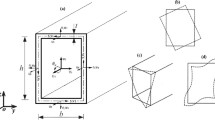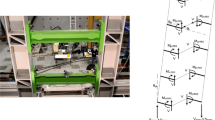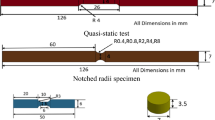Abstract
The beam-column connections are generally failed due to geometrical and material properties of connection under seismic conditions. Towards damage control of the connection, the forces must be mitigated away from the connection. The steel plates are used as a structural fuse that receives the forces from connection and fail first. The steel plates are not only used as dissipative fuse and also used as alternative force transfer path, which increases the moment capacity of the connection. In this research, a novel beam-column end-plate resilient connection is proposed. The connection is made resilient by incorporating the structural fuse. Two different types of fuses, such as single and dual fuse are modelled. The shape of the fuse has vital importance and it is modelled in the shape of an hourglass. The main objective of the current research is to study the effect of single fuse, dual fuse and combined action of fuse and damper in beam-column end-plate connection under cyclic loading. The objective is attained by two different types of studies such as component method and finite element analysis (FEA). The mechanical model is developed for the novel end-plate connection based on Eurocode 3. The parametric analysis is conducted using the component approach to study the effect of connection components such as end-plate thickness, bolt diameter and number of bolts. The appropriate geometrical configuration of the fuse plate is obtained using finite element analysis. The specimens are configured as five different forms based upon the number of fuses (single and dual fuse), the position of fuse (beam top flange alone, both top and bottom flange) and subjected to monotonic and cyclic loading. The moment of resistance, hysteresis response, stiffness, energy dissipation capacity and strain in the fuse were critically assessed in the present investigation. In the comparison of single and dual fuse, the ultimate moment of dual fuse is marginally higher than single fuse. The fuses present in the tension region directly took part in enhancing the moment capacity of connection whereas the fuses in the compression side were acted as a damping element which circuitously enhanced the moment capacity. Under cyclic conditions, it is good to have fuse on both sides (tension and compression) to get the benefit of both fuse and damping action.



































Similar content being viewed by others
References
Kim T, Whittaker AS, Gilani ASJ, Bertero VV, Takhirov SM (2002) Cover-plate and flange-plate steel moment-resisting connections. J Struct Eng 28(4):474–482. https://doi.org/10.1061/(ASCE)0733-9445(2002)128:4(474)
Richard Liew JY, Teo TH, Shanmugam NE (2004) Composite joints subject to reversal of loading—Part 1: experimental study. J Constr Steel Res 60:221–246. https://doi.org/10.1016/j.jcsr.2003.08.010
Lachal A, Aribert JM, Loho G (2005) Static design and cyclic behavior of end-plate steel and composite joints strengthened by haunches. Adv in steel struct 2:1353–1358. https://doi.org/10.1016/B978-008044637-0/50201-8
Shi G, Shi Y, Wang Y (2007) Behaviour of end-plate moment connections under earthquake loading. Eng Struct 29:703–716. https://doi.org/10.1016/j.engstruct.2006.06.016
Pachoumis DT, Galoussis EG, Kalfas CN, Christitsas AD (2009) Reduced beam section moment connections subjected to cyclic loading: Experimental analysis and FEM simulation. Eng Struct 31:216–223. https://doi.org/10.1016/j.engstruct.2008.08.007
Sai Chandana B, Arunkumar C, Umamaheswari N (2020) Experimental and numerical investigation on the moment rotation behavior of cruciform moment connections with reduced beam sections. J Inst Eng India Ser A 101(1):57–67. https://doi.org/10.1007/s40030-019-00410-x
Sofias CE, Kalfas CN, Pachoumis DT (2014) Experimental and FEM analysis of reduced beam section moment endplate connections under cyclic loading. Eng Struct 59:320–329. https://doi.org/10.1016/j.engstruct.2013.11.010
Garoosi AM, Roudsari MT, Hashemi BH (2018) Experimental evaluation of rigid connection with reduced section and replaceable fuse. Structures 16:390–404. https://doi.org/10.1016/j.istruc.2018.11.010
Özkılıç YO (2020) A new replaceable fuse for moment resisting frames: Replaceable bolted reduced beam section connections. Steel Compos Struct 35(3):353–370. https://doi.org/10.12989/scs.2020.35.3.353
Latour M, Piluso V (2011) Experimental analysis of innovative dissipative bolted double split tee beam-to-column connections. Steel Constr 4(2):53–64. https://doi.org/10.1002/stco.201110009
Sang-Hoon Oh, Kim Y-J, Ryu H-S (2009) Seismic performance of steel structures with slit dampers. Eng Struct 31:1997–2008. https://doi.org/10.1016/j.engstruct.2009.03.003
Köken A, Köroğlu MA (2015) Experimental study on beam-to-column connections of steel frame structures with steel slit dampers. J Perform Constr Facil 29(2):04014066. https://doi.org/10.1061/(ASCE)CF.1943-5509.0000553
Sahoo DR, Singhal T, Taraithia SS, Saini A (2015) Cyclic behavior of shear-and-flexural yielding metallic dampers. J Constr Steel Res 114:247–257. https://doi.org/10.1016/j.jcsr.2015.08.006
Lee C-H, Lho S-H, Kim D-H, Jintak Oh, Ju YK (2016) Hourglass-shaped strip damper subjected to monotonic and cyclic loadings. Eng Struct 119:122–134. https://doi.org/10.1016/j.engstruct.2016.04.019
Banisheikholeslami A, Behnamfar F, Ghandil M (2016) A beam-to-column connection with visco-elastic and hysteretic dampers for seismic damage control. J Constr Steel Res 117:185–195. https://doi.org/10.1016/j.jcsr.2015.10.016
Hsu HL, Halim H (2017) Improving seismic performance of framed structures with steel curved dampers. Eng Struct 130:99–111. https://doi.org/10.1016/j.engstruct.2016.09.063
Stratan A, Dubina D (2004) Bolted links for eccentrically braced steel frames. In: Proceedings of the 5th AISC/ECCS international workshop: connections in steel structures V. behaviour, strength and design, Delft, The Netherlands, pp 223–332
Dubina D, Stratan A, Dinu F (2008) Dual high-strength steel eccentrically braced frames with removable links. Earthq Eng Struct Dyn 37:1703–1720. https://doi.org/10.1002/eqe.828
Shen Y, Christopoulos C, Mansour N, Tremblay R (2011) Seismic design and performance of steel moment-resisting frames with nonlinear replaceable links. J Struct Eng 137(10):1107–1117. https://doi.org/10.1061/(ASCE)ST.1943-541X.0000359
Chan RWK, Albermani F, Kitipornchai S (2013) Experimental study of perforated yielding shear panel device for passive energy dissipation. J Constr Steel Res 91:14–25. https://doi.org/10.1016/j.jcsr.2013.08.013
Nikoukalam MT, Dolatshahi KM (2015) Development of structural shear fuse in moment resisting frames. J Constr Steel Res 114:349–361. https://doi.org/10.1016/j.jcsr.2015.08.008
Mahmoudi F, Dolatshahi KM, Mahsuli M, Nikoukalam MT, Shahmohammadi A (2019) Experimental study of steel moment resisting frames with shear link. J Constr Steel Res 154:197–208. https://doi.org/10.1016/j.jcsr.2018.11.027
Richards P (2019) A repairable connection for earthquake resisting moment frames. Steel Constr 12(3):191–197. https://doi.org/10.1002/stco.201900015
Richards PW, Oh SS (2019) Cyclic behavior of replaceable shear fuse connections for steel moment frames. J Struct Eng 145(12):04019156. https://doi.org/10.1061/(ASCE)ST.1943-541X.0002412
Castiglioni CA, Kanyilmaz A, Calado L (2012) Experimental analysis of seismic resistant composite steel frames with dissipative devices. J Constr Steel Res 76:1–12. https://doi.org/10.1016/j.jcsr.2012.03.027
Calado L, Proença JM, Sio J (2020) Seismic design and assessment of steel-concrete frame structures with welded dissipative fuses. Steel Compos Struct 35(4):527–544. https://doi.org/10.12989/SCS.2020.35.4.527
Valente M, Castiglioni CA, Kanyilmaz A (2017) Numerical investigations of repairable dissipative bolted fuses for earthquake resistant composite steel frames. Eng Struct 131:275–292. https://doi.org/10.1016/j.engstruct.2016.11.004
Yan J-B, Chen Y, Lin X (2020) Finite element analysis and parametric studies on hysteretic behaviours of high strength steel T-joints with damage-control fuses. Thin Wall Struct 148:106574. https://doi.org/10.1016/j.tws.2019.106574
Mahmood Shah AS, Moradi S (2020) Cyclic response sensitivity of energy dissipating steel plate fuses. Structures 23:799–811. https://doi.org/10.1016/j.istruc.2019.12.026
Lin X, Chen Y, Yan J-B, Yangyang Hu (2020) Seismic behavior of welded beam-to-column joints of high-strength steel-moment frame with replaceable damage-control fuses. J Struct Eng 146(8):04020143. https://doi.org/10.1061/(ASCE)ST.1943-541X.0002691
Irvani M, Ezati H, Khafajeh R, Jaari VRK (2022) Numerically study on the seismic response of partially restrained moment connection with structural fuse T-stub for European sections. Structures 35:82–105
IS 808 (1989) Dimensions for hot rolled steel beam, column, channel and angle sections. Bureau of Indian Standard, New Delhi
ABAQUS 6.14 (2014) Dassault Systèmes Simulia Corp., Providence
Krolo P, Grandic D, Bulic M (2016) The guidelines for modelling the preloading bolts in the structural connection using finite element methods. J Comput Eng 2016:1–8. https://doi.org/10.1155/2016/4724312
FEMA 350 (2000) Recommended seismic design criteria for new steel moment-frame building. Federal Emergency Management Agency, Washington, DC
Eurocode 3 (2005) Design of steel structures, part 1.8: design of joints. European Committee for Standardization, Brussels
Adegoke IO, Kemp AR (2003) Moment-rotation relationships of thin end-plate connections in steel beams. In: Proceedings of the international conference on advances in structures, Sydney
Richard RM (1961) A study of structural systems having conservative nonlinear elements. Doctoral dissertation, Purdue University, Indiana, United states
Eurocode 3 (2005) Design of steel structures. Part 1.1: general rules and rules for buildings. European Committee for Standardization, Brussels
De Lima LRO, Simoes da Silva L, Vellasco PCGDS, De Andrade SAL (2004) Experimental evaluation of extended endplate beam-to-column joints subjected to bending and axial force. Eng Struct 26:1333–1347. https://doi.org/10.1016/j.engstruct.2004.04.003
Alhasawi A, Guezouli S, Couchaux M (2017) Component-based model versus stress-resultant plasticity modelling of bolted end-plate connection: numerical implementation. Structures 11:164–177. https://doi.org/10.1016/j.istruc.2017.05.004
Astaneh A, Nader MN, Malik L (1989) Cyclic behavior of double angle connections. J Struct Eng 115:1101–1118. https://doi.org/10.1061/(ASCE)0733-9445(1989)115:5(1101)
Author information
Authors and Affiliations
Corresponding author
Ethics declarations
Conflict of interest
No potential conflict of interest was reported by the authors.
Ethical approval
This article does not contain any studies with human participants or animals performed by any of the authors.
Informed consent
For this type of study formal consent is not required.
Supplementary Information
Below is the link to the electronic supplementary material.
Rights and permissions
About this article
Cite this article
Arunkumar, C., Umamaheswari, N. Numerical study on the behaviour of resilient beam-column end plate connection with dual structural fuse. Innov. Infrastruct. Solut. 7, 222 (2022). https://doi.org/10.1007/s41062-022-00807-x
Received:
Accepted:
Published:
DOI: https://doi.org/10.1007/s41062-022-00807-x




